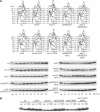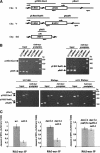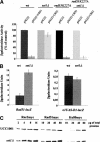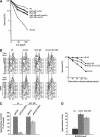The set1Delta mutation unveils a novel signaling pathway relayed by the Rad53-dependent hyperphosphorylation of replication protein A that leads to transcriptional activation of repair genes
- PMID: 11459833
- PMCID: PMC312739
- DOI: 10.1101/gad.193901
The set1Delta mutation unveils a novel signaling pathway relayed by the Rad53-dependent hyperphosphorylation of replication protein A that leads to transcriptional activation of repair genes
Abstract
SET domain proteins are present in chromosomal proteins involved in epigenetic control of transcription. The yeast SET domain protein Set1p regulates chromatin structure, DNA repair, and telomeric functions. We investigated the mechanism by which the absence of Set1p increases DNA repair capacities of checkpoint mutants. We show that deletion of SET1 induces a response relayed by the signaling kinase Rad53p that leads to the MEC1/TEL1-independent hyperphosphorylation of replication protein A middle subunit (Rfa2p). Consequently, the binding of Rfa2p to upstream repressing sequences (URS) of repair genes is decreased, thereby leading to their derepression. Our results correlate the set1Delta-dependent phosphorylation of Rfa2p with the transcriptional induction of repair genes. Moreover, we show that the deletion of the amino-terminal region of Rfa2p suppresses the sensitivity to ultraviolet radiation of a mec3Delta checkpoint mutant, abolishes the URS-mediated repression, and increases the expression of repair genes. This work provides an additional link for the role of Rfa2p in the regulation of the repair capacity of the cell and reveals a role for the phosphorylation of Rfa2p and unveils unsuspected connections between chromatin, signaling pathways, telomeres, and DNA repair.
Figures







Similar articles
-
Interaction between Set1p and checkpoint protein Mec3p in DNA repair and telomere functions.Nat Genet. 1999 Feb;21(2):204-8. doi: 10.1038/5991. Nat Genet. 1999. PMID: 9988274
-
Requirement of the Mre11 complex and exonuclease 1 for activation of the Mec1 signaling pathway.Mol Cell Biol. 2004 Nov;24(22):10016-25. doi: 10.1128/MCB.24.22.10016-10025.2004. Mol Cell Biol. 2004. PMID: 15509802 Free PMC article.
-
The budding yeast Rad9 checkpoint protein is subjected to Mec1/Tel1-dependent hyperphosphorylation and interacts with Rad53 after DNA damage.EMBO J. 1998 Oct 1;17(19):5679-88. doi: 10.1093/emboj/17.19.5679. EMBO J. 1998. PMID: 9755168 Free PMC article.
-
Is Rad9p upstream or downstream from Mec1p?Cold Spring Harb Symp Quant Biol. 2000;65:347-51. doi: 10.1101/sqb.2000.65.347. Cold Spring Harb Symp Quant Biol. 2000. PMID: 12760049 Review. No abstract available.
-
The FHA domain in DNA repair and checkpoint signaling.Cold Spring Harb Symp Quant Biol. 2000;65:423-31. doi: 10.1101/sqb.2000.65.423. Cold Spring Harb Symp Quant Biol. 2000. PMID: 12760058 Review. No abstract available.
Cited by
-
Replication protein A is sequentially phosphorylated during meiosis.Nucleic Acids Res. 2001 Dec 1;29(23):4808-17. doi: 10.1093/nar/29.23.4808. Nucleic Acids Res. 2001. PMID: 11726690 Free PMC article.
-
Dumpy-30 family members as determinants of male fertility and interaction partners of metal-responsive transcription factor 1 (MTF-1) in Drosophila.BMC Dev Biol. 2008 Jun 27;8:68. doi: 10.1186/1471-213X-8-68. BMC Dev Biol. 2008. PMID: 18588663 Free PMC article.
-
Methylated H3K4, a transcription-associated histone modification, is involved in the DNA damage response pathway.PLoS Genet. 2010 Aug 26;6(8):e1001082. doi: 10.1371/journal.pgen.1001082. PLoS Genet. 2010. PMID: 20865123 Free PMC article.
-
The essential WD repeat protein Swd2 has dual functions in RNA polymerase II transcription termination and lysine 4 methylation of histone H3.Mol Cell Biol. 2004 Apr;24(7):2932-43. doi: 10.1128/MCB.24.7.2932-2943.2004. Mol Cell Biol. 2004. PMID: 15024081 Free PMC article.
-
Spp1 at the crossroads of H3K4me3 regulation and meiotic recombination.Epigenetics. 2013 Apr;8(4):355-60. doi: 10.4161/epi.24295. Epub 2013 Mar 19. Epigenetics. 2013. PMID: 23511748 Free PMC article. Review.
References
-
- Allen JB, Zhou Z, Siede W, Friedberg EC, Elledge SJ. The SAD1/RAD53 protein kinase controls multiple checkpoints and DNA damage-induced transcription in yeast. Genes & Dev. 1994;8:2416–2428. - PubMed
-
- Brill SJ, Stillman B. Replication factor-A from Saccharomyces cerevisiae is encoded by three essential genes coordinately expressed at S phase. Genes & Dev. 1991;5:1589–1600. - PubMed
Publication types
MeSH terms
Substances
LinkOut - more resources
Full Text Sources
Other Literature Sources
Molecular Biology Databases
Research Materials
